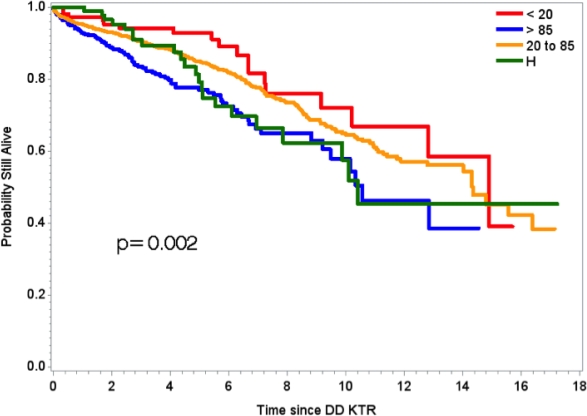Survival in Deceased Donor Kidney Transplant by Kidney Donor Profile Index versus Intensive Home Hemodialysis
1Internal Medicine, University of Virginia, Charlottesville, VA
2Public Health Science, University of Virginia, Charlottesville, VA
3Lynchburg Nephrology Physicians, Lynchburg, VA.
Meeting: 2018 American Transplant Congress
Abstract number: D64
Keywords: Cadaveric organs, Kidney transplantation, Survival
Session Information
Session Name: Poster Session D: Kidney Complications: Late Graft Failure
Session Type: Poster Session
Date: Tuesday, June 5, 2018
Session Time: 6:00pm-7:00pm
 Presentation Time: 6:00pm-7:00pm
Presentation Time: 6:00pm-7:00pm
Location: Hall 4EF
In an era of donor scarcity, high Kidney Donor Profile Index (KDPI) >85% organs can serve as a pathway to timely transplant. We previously reported comparable patient survival between intensive home hemodialysis (IHHD) and deceased donor (DD) kidney transplant (KT). Herein, we extended our analysis of patient survival with IHHD compared to DDKT stratified by KDPI group.
We included all adult patients receiving first, single DDKT or starting IHHD in the same US state between October 1997 and June 2014. KT data was obtained from SRTR and IHHD data from a experienced nephrology practice in the same state. IHHD was defined as >20hrs/week or ≥4 sessions/week. KDPI groups were as follows: low 0-20%, standard 21-85% and high >85%. Overall survival (OS) was estimated by Kaplan Meier method and we used Cox proportional hazards regression for hazard ratio (HR) calculation.
We identified 1834 DDKT recipients and 116 IHHD patients. Recipients of high KDPI organs were older and more frequently male. IHHD patients had slightly higher BMI and had more ESRD due to glomerulonephritis. Presence of diabetes was similar across all groups. Median OS for low, standard and high KDPI recipients was 14.9, 14.3 and 10.6 years, respectively. IHHD patients had similar OS (10.4 years) to high KDPI recipients. High KDPI recipients had higher mortality compared to low KDPI recipients (HR 2.1, 95% CI 1.26-3.50, p<0.005). There was no difference in patient survival between IHHD and DDKT by KDPI groups (figure 1); HR for low vs. IHHD was 0.64 (95% CI 0.34-1.20, p=0.16) and high vs. IHHD was 0.88 (95% CI 0.57-1.35, p=0.55). Interestingly, IHHD patients seemed to have better survival than high KDPI recipients within the first 5 years. 
Survival in a selected IHHD cohort was not statistically different from DDKT regardless of KDPI group. IHHD could possibly serve as a bridging therapy to KT and perhaps, an alternative for those who can only expect to receive high KDPI organs.
CITATION INFORMATION: Nishio-Lucar A., Lyons G., Bose S., Ma J., Awuah K., Lockridge R. Survival in Deceased Donor Kidney Transplant by Kidney Donor Profile Index versus Intensive Home Hemodialysis Am J Transplant. 2017;17 (suppl 3).
To cite this abstract in AMA style:
Nishio-Lucar A, Lyons G, Bose S, Ma J, Awuah K, Lockridge R. Survival in Deceased Donor Kidney Transplant by Kidney Donor Profile Index versus Intensive Home Hemodialysis [abstract]. https://atcmeetingabstracts.com/abstract/survival-in-deceased-donor-kidney-transplant-by-kidney-donor-profile-index-versus-intensive-home-hemodialysis/. Accessed December 12, 2025.« Back to 2018 American Transplant Congress
